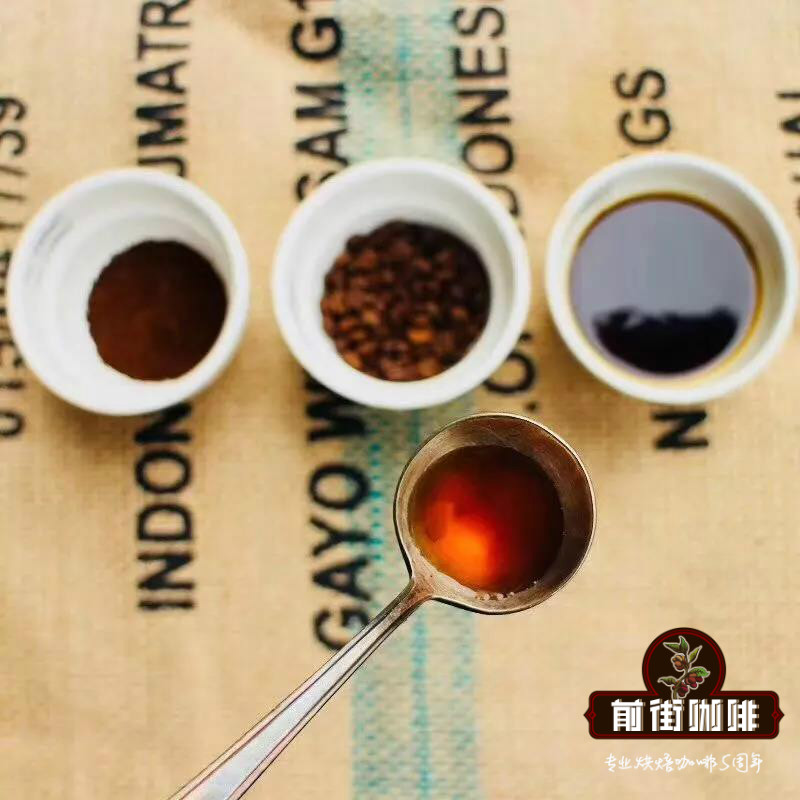Beans of World Fine Coffee introduction to the characteristics of World Fine Coffee

Professional coffee knowledge exchange More coffee bean information Please pay attention to coffee workshop (Weixin Official Accounts cafe_style)
Low acid, low bitterness, mellow taste, rich aroma type
The beans in this series are mainly Asian beans. Brazil in the Americas is the largest coffee producer, but it is also included in this category because of its slightly monotonous taste. The typical Asian and island flavors are characterized by a higher body than Central and South American beans and African beans, but a lower acidity, with a hint of wood, herbs, spices and earth, and a low smoky aroma over an elevated acid aroma. Island beans are light and mild, with a light and elegant tone. When it comes to Asian coffee, coffee lovers 'first impression is often thick and steady. Because of the heavy weight of Asian coffee, it is very suitable as a base for making Italian coffee blends. Asian green coffee beans are generally processed by wet or semi-wet processing. Most of the green beans are uniform, but the color of the beans after semi-wet processing is darker. Asian coffee is generally characterized by a heavy flavor, intense sweetness and roundness, but the aroma and brightness are slightly flat.
1. Indonesia: moderate bitterness, herbal and earthy fragrance, chocolate, sweet syrup, mellow taste
Beans: Java, Mandheling, Ankola, Kopi Luwak
Coffee is produced throughout Indonesia, and Java occupies an extremely important place in the history of coffee. Indonesia is the world's leading producer of Robusta coffee, producing 6.8 million bags of coffee a year, mostly from small plantations, accounting for about 90% of total production. The best growing areas of the whole archipelago are Java, Sumatra, Sulawesi and Flores.
Java produces fine aromatic coffee with relatively low acidity, fine taste and good balance. Java coffee has a superior aroma and acidity to Sumatra and Sulawesi coffees. The best plantations in Java are Bravan, Jambit, Kayumas and Pankur. Java mocha coffee is a blend of Java coffee and Yemeni mocha coffee.
Coffee from Sumatra, Indonesia's second largest island, is even more striking, similar to Java coffee but slightly heavier in size. Mandheling and Ankola coffee beans are also highly valued, the former even being hailed as the world's most granular coffee beans.
The island of Sulawesi, located between Borneo and New Guinea, is sometimes called Celebes. The coffee produced on the island is rich in grain and aroma, and the best beans are produced in the south of the island, in Carlosi and Rand.
One of the main coffee producers in New Guinea is Sigri Plantation, which produces a full-grain, well-balanced product that is consistent with the overall style of archipelagic coffee.
Overall, Indonesian coffee tastes strong, mellow, slightly syrupy, excellent acidity, slightly like Chinese medicine and earthy taste. Its two main export markets are Germany and Japan, which reflects the excellent quality of the coffee. What appeals to consumers is the exceptional quality of its Arabica beans. Indonesian coffee is divided into six grades, the best is AP.
In particular, there is a special animal in the mountains of Indonesia called the civet (currently in captivity in Taiwan and Yunnan), because it makes Indonesia produce one of the world's most expensive coffees-cat dung coffee. The cat loves coffee berries, and the hard coffee beans end up being excreted because they can't be digested. During the passage through the digestive tract, coffee beans undergo fermentation to produce a unique and complex aroma, which makes many consumers like this coffee with special aroma. But because production is so low (real wild civet coffee is only a few dozen to hundreds of kilograms a year), it sells for hundreds of dollars a pound. Also because of the limelight, IVY saw N more civet signature coffee at the Guangzhou Coffee Expo in December 2014, mainly from Indonesia and Vietnam, but most of them were captive civet cats. The sample size placed on site was several times that of real civet coffee production.
2. China: moderate acidity, mild flavor
Mainland beans: Yunnan coffee, Hainan coffee; Taiwan beans: Guoxing coffee, Gukeng coffee, Zhongpu coffee, Dongshan coffee, Dawushan coffee, Alishan Mafei coffee (Zou coffee), Mizuho coffee (Hualien coffee), Jiufen Ershan coffee, Chiayi Ruili Huojingu coffee
A typical representative of the mainland of China is Yunnan Arabica coffee. Yunnan mainly grows two classic high-quality coffee varieties, Typica and Bourbon. In 1991, Katimo Catimor series varieties (stronger virus resistance and higher yield) were introduced from Kenya, belonging to Arabian species (also known as small species). Yunnan Arabica coffee planting areas are mainly distributed in Lincang, Baoshan, Simao, Xishuangbanna, Dehong and other prefectures. Most of them are planted on mountains with an altitude of 800~1800 meters, and mainly processed by Colombia wet method, so the sour taste is moderate, the flavor is rich and mellow.
3. Brazil: low acidity, light sweetness, neutral alcohol, single taste
Beans: Santos, Bahia, Cerrado, Mogiana
Brazil's coffee quality is average, but less excellent quality of fine coffee, its beans are softer, roasting process is obviously not resistant to heat, among the varieties known as Santos, is named for its export port Santos/Santos.
Brazilian coffee beans are neutral in nature and have no outstanding advantages, but there are no obvious defects. This taste is mild and smooth, low in acidity, moderate in alcohol, and slightly sweet. It can be tasted as a single (although a little monotonous). However, because it is so mild and ordinary, Santos/Santos is suitable for ordinary roasting and brewing in the most popular way. It is the best raw material for making espresso and various fancy coffees.
4. Ecuador: neutral flavor, alcohol neutral
Beans: Galápagos, Gigante
Ecuador has the highest Arabica coffee plantations in the world. Ecuador actually means "equator" in Spanish. Due to the use of old-fashioned traditional harvesting and processing methods, Ecuadorian coffee is not listed as a fine coffee, so it is generally less seen and unfamiliar. Ecuador faces the Pacific Ocean, about 900 kilometers off its west coast near the equator at 90 degrees west longitude, there is a Galapagos Island (Galapagos Island) is also its territory, also known as Colón Island, producing the famous Galapagos coffee. In order to protect the natural ecology, the Ecuadorian government has designated the archipelago as a national park, and banned the use of chemical fertilizers, pesticides and other chemicals, so the coffee in the Galapagos Islands is recognized as organic coffee. Galapagos coffee is balanced and neutral, with a medium body, a distinct but pleasant acidity, and a distinctive aroma.
5. Venezuela: light, low acid
Beans: Montebello, Miramar, Granija, Ala Granija
One of the many plantations in Merida below the Andes, belonging to the Pablo and Luisa Helena Pulido families, is an ancient farm that has been allowed to downsize. Since taking over the farm in the early 1980s, the Pulidos have grown new species while harvesting coffee from existing bourbon trees.
Venezuelan coffee tastes different from other Latin American coffees in that it is delicious, light and less sour than traditional coffee, which makes it not only blended but also unique.
6. Nicaragua: good fragrance, balanced taste and clarity
Beans: Jinotega, Nuevo Segovia
Coffee in Nicaragua is grown mainly in the central and northern parts of the country and is characterized by shade cultivation. Coffee beans are washed and dried in the sun. Generally speaking, Nicaragua coffee is less distinctive, so common Nicaraguan beans are often used for mixed coffee or instant coffee.
However, high-quality Nicaragua beans such as maragogipe (a tree species called elephant bean) are highly rated because it has a balanced taste, does not have the bright acid often found in other Central American coffees, but has a clear taste and excellent aroma. This rounded and soft texture also makes it stand out from the generally moderate evaluation of Guatemalan coffee and is loved by many people.
7. Mexico: Aromatic and attractive, sour and mild, mellow and smooth
Beans: Coatepec, Huatusco, Orizaba, Maragogype, Tapanchula, Huixtla, Pluma Coixtepec, Liquidambar MS
Mexico borders the United States to the north, and its coffee production ranks fourth in the world. It is mainly produced in the southeast adjacent to the Vivitenango Highlands of Guatemala. Mexican coffee beans are large in size and produce coffee that is soft, mellow and aromatic. Among them, the giant elephant bean tree Maragogipe (also known as Maragogype) produces coffee beans that are not only three times larger than normal, but also known for their mellow and round taste. Farmers 'poverty means that most coffee is grown naturally, without chemicals such as pesticides or fertilizers, producing excellent coffee. Mexican coffee is lighter in color, more acidic, crispy in taste and refreshing.
8. Haiti: rich flavor, mild taste
Beans: Yauco Selecto, Grand Lares Yauco
Most of the coffee produced in Haiti is grown purely naturally, not intentionally but as a result of shortages, because farmers are too poor to afford fungicides, pesticides and fertilizers. The main coffee-growing region of Haiti is the north of the country. Haiti coffee has a wider variety of brands, grades and varieties than any other country. In Japan, Haiti coffee is blended with Jamaica Blue Mountain coffee to give it a stronger flavor. Haiti coffee particles full, rich flavor, acidity from medium to low, taste mild, especially suitable for brewing espresso coffee.
Important Notice :
前街咖啡 FrontStreet Coffee has moved to new addredd:
FrontStreet Coffee Address: 315,Donghua East Road,GuangZhou
Tel:020 38364473
- Prev

Why does steaming fail? what is the use of steaming coffee? why is coffee steaming?
Professional coffee knowledge exchange more coffee bean information Please pay attention to the coffee workshop (Wechat official account cafe_style) hand flush, we knew to let the coffee powder to be steamed first, but many people were also defeated by this step, what on earth is the purpose of steaming? And why did your own steaming fail? Today, Qianjie Coffee is here to analyze the reasons for the failure of steaming. So
- Next

Introduction of Coffee varieties in the World Coffee characteristics of the world's boutique coffee producing areas
Professional coffee knowledge exchange more coffee bean information Please follow the coffee workshop (Wechat official account cafe_style) low sour, low bitter, mellow taste, rich aroma this series of beans are mainly Asian beans, although Brazil in the Americas is the largest coffee producer, it is also included in this category because of its slightly monotonous taste. The typical Asian bean and island flavor is characterized by medium alcohol thickness ratio.
Related
- Beginners will see the "Coffee pull flower" guide!
- What is the difference between ice blog purified milk and ordinary milk coffee?
- Why is the Philippines the largest producer of crops in Liberia?
- For coffee extraction, should the fine powder be retained?
- How does extracted espresso fill pressed powder? How much strength does it take to press the powder?
- How to make jasmine cold extract coffee? Is the jasmine + latte good?
- Will this little toy really make the coffee taste better? How does Lily Drip affect coffee extraction?
- Will the action of slapping the filter cup also affect coffee extraction?
- What's the difference between powder-to-water ratio and powder-to-liquid ratio?
- What is the Ethiopian local species? What does it have to do with Heirloom native species?

